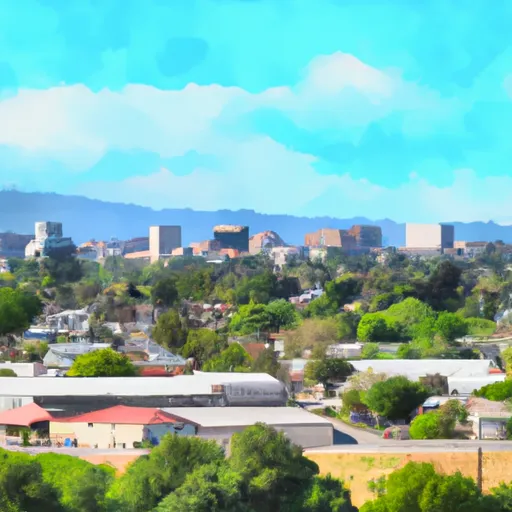-
 Snoflo Premium
Snoflo Premium
Get unlimited access to all our content
With no Ad interruptions! - Start Your Free Trial Login with existing account
Romoland
Eden Index
Climate
8.8
•
Recreation
5.7
•
Community
2.9
•
Safeguard
6.2/10

Romoland is a small unincorporated community located in Riverside County, California. Situated in the southwestern region of the state, Romoland experiences a Mediterranean climate characterized by hot, dry summers and mild, wet winters. Summers can reach temperatures as high as 100°F, while winters see average temperatures of around 65°F. Precipitation is relatively low, with an average of 12 inches per year, mostly occurring during the winter months.
As for hydrology constituents, Romoland lies within the Santa Ana River watershed. The Santa Ana River, which flows nearby, is a significant water resource in the region. Additionally, groundwater is an essential source of water supply for the community.
In terms of outdoor recreation opportunities, Romoland is surrounded by natural beauty and offers various activities. Nearby Lake Perris State Recreation Area provides opportunities for boating, fishing, camping, and hiking. Additionally, the Santa Rosa Plateau Ecological Reserve is a short drive away, offering picturesque hiking trails through diverse landscapes, including rare vernal pools and oak woodlands. With its pleasant climate and proximity to natural attractions, Romoland provides residents and visitors with ample opportunities to enjoy the outdoors and explore the region's natural beauty.
What is the Eden Index?
The Snoflo Eden Index serves as a comprehensive rating system for regions, evaluating their desirability through a holistic assessment of climate health, outdoor recreation opportunities, and natural disaster risk, acknowledging the profound impact of these factors on livability and well-being.
Climate Health Indicator (CHI): 8.8
Romoland receives approximately
291mm of rain per year,
with humidity levels near 75%
and air temperatures averaging around
18°C.
Romoland has a plant hardyness factor of
9, meaning
plants and agriculture in this region tend to thrive here all year round.
By considering the ideal temperature range, reliable water supplies, clean air, and stable seasonal rain or snowpacks, the Climate Health Indicator (CHI) underscores the significance of a healthy climate as the foundation for quality living.
A healthy climate is paramount for ensuring a high quality of life and livability in a region, fostering both physical well-being and environmental harmony. This can be characterized by ideal temperatures, reliable access to water supplies, clean air, and consistent seasonal rain or snowpacks.
Weather Forecast
Streamflow Conditions
Santa Ana
Area Rivers
Santa Ana
Snowpack Depths
Santa Ana
Reservoir Storage Capacity
Santa Ana
Groundwater Levels
Recreational Opportunity Index (ROI): 5.7
The Recreational Opportunity Index (ROI) recognizes the value of outdoor recreational options, such as parks, hiking trails, camping sites, and fishing spots, while acknowledging that climate plays a pivotal role in ensuring the comfort and consistency of these experiences.
Access to outdoor recreational opportunities, encompassing activities such as parks, hiking, camping, and fishing, is crucial for overall well-being, and the climate plays a pivotal role in enabling and enhancing these experiences, ensuring that individuals can engage in nature-based activities comfortably and consistently.
Camping Areas
| Campground | Campsites | Reservations | Toilets | Showers | Elevation |
|---|---|---|---|---|---|
| Lake Skinner | None | 1,514 ft | |||
| Lake Perris State Rec Area | 351 | 1,600 ft | |||
| Lake ONeill Military | None | 135 ft | |||
| Lake Elsinore | 400 | 1,286 ft | |||
| Yucaipa Regional Park | 51 | 2,658 ft | |||
| Dripping Springs | 23 | 1,644 ft | |||
| Wildomar | 11 | 2,456 ft | |||
| March ARB Military | None | 1,509 ft |
Catastrophe Safeguard Index (CSI):
The Catastrophe Safeguard Index (CSI) recognizes that natural disaster risk, encompassing floods, fires, hurricanes, and tornadoes, can drastically affect safety and the overall appeal of an area.
The level of natural disaster risk in a region significantly affects safety and the overall livability, with climate change amplifying these risks by potentially increasing the frequency and intensity of events like floods, fires, hurricanes, and tornadoes, thereby posing substantial challenges to community resilience and well-being.
Community Resilience Indicator (CRI): 2.9
The Community Resilience Indicator (CRI) recognizes that education, healthcare, and socioeconomics are crucial to the well-being of a region. The CRI acknowledges the profound impact of these elements on residents' overall quality of life. By evaluating educational resources, healthcare accessibility, and economic inclusivity, the index captures the essential aspects that contribute to a thriving community, fostering resident satisfaction, equity, and social cohesion.

